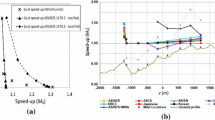Abstract
A three-dimensional nonlinear numerical model, that has been extensively used previously to predict environmental water flows, was applied to predict the flow over an isolated hill, Askervein. Predictions are reported for winds approaching the hill from 210 ° and 180 ° clockwise from north, both under almost neutral atmospheric conditions.
The model predictions were compared with data collected during a major field study in 1983. From the comparisons it was concluded that the model predicts the mean flow variables with good accuracy. Larger discrepancies were found for quantities related to the turbulence, pointing to deficiencies in the turbulence model, and perhaps in some of the measurements.
Similar content being viewed by others
References
Beljaars, A. C. M., Walmsley, J. L., and Taylor, P. A.: 1986, ‘A Mixed Spectral Finite-Difference Model for Neutrally Stratified Boundary-Layer Flow over Roughness Changes and Topography’, Boundary-Layer Meteorol. 38, 273–303.
Freeman, N. G., Hale, A. M., and Danard, M. B.: 1972, ‘A Modified Sigma Equations Approach to the Numerical Modelling of Great Lakes Hydrodynamics’, J. Geophys. Res. 77, 1050–1060.
Harlow, F. H. and Welch, J. E.: 1965, ‘Numerical Calculation of Time-Dependent Viscous Incompressible Flow of Fluid with Free Surface’, Phys. Fluids 8, 2182–2189.
Hutchinson, B. R.: 1985, ‘Predictions of Three-Dimensional Flows in Channels and Rivers’, Ph.D. Thesis, Mech. Eng., University of Waterloo.
Hutchinson, B. R. and Raithby, G. D.: 1986, ‘A Multigrid Method Based on the Additive Correction Strategy’, Numerical Heat Transfer 9, 511–537.
Jackson, P. S. and Hunt, J. C. R.: 1975, ‘Turbulent Wind Flow Over a Low Hill’, Quart. J. R. Meteorol. Soc. 101, 929–955.
Klebanoff, P. S.: 1955, Characteristics of Turbulence in a Boundary Layer with Zero Pressure Gradient, NACA Report 1247.
Launder, B. E. and Spalding, D. B.: 1974, ‘The Numerical Computation of Turbulent Flows’, Computer Methods in Appl. Mech. Eng. 3, 269–289.
Mason, P. J. and Sykes, R. I.: 1979, ‘Flow over an Isolated Hill of Moderate Slope’, Quart. J. R. Meteorol. Soc. 105, 383–395.
Panofsky, H. A. and Dutton, J. A.: 1984, Atmospheric Turbulence Models and Methods for Engineering Applications, John Wiley and Sons, New York, p. 160.
Phillips, N. A.: 1957, ‘A Coordinate System Having Some Special Advantages for Numerical Forecasting’, J. Meteorol. 14, 184–185.
Raithby, G. D.: 1984, Predictions of Thermal Plumes at the Bruce Nuclear Power Development, Thermal Science Ltd. report to Ontario Hydro.
Raithby, G. D. and Elliott, R. V.: 1982, The Prediction of Thermal Discharge Entering a Crossflow, Int. Symp. on Refined Modelling of Flows, ASCE, Paris.
Rodi, W.: 1981, Comparison of Computation with Experiment, The 1980–81 AFOSR-HTTM Stanford Conference on Complex Turbulent Flows: Comparison of Computation and Experiment, Stanford, California.
Taylor, P. A.: 1977, ‘Some Numerical Solutions of Surface Boundary-Layer Flow above Gentle Topography’, Boundary-Layer Meteorol. 11, 439–465.
Taylor, P. A. and Teunissen, H. W.: 1983, Askervein '82: Report on the September/October 1982 Experiment to Study Boundary Layer Flow over Askervein, South Uist, Report MSRB-83–8, Atmos. Environ. Service, Downsview, Ontario.
Taylor, P. A. and Teunissen, H. W.: 1985, The Askervein Hill Project: Report on the September/October 1983 Main Field Experiment, Report MSRB-84–6, Atmos. Environ. Service, Downsview, Ontario.
Taylor, P. A. and Teunissen, H. W.: 1987, ‘The Askervein Hill Project: Overview and Background Data’, Boundary-Layer Meteorol. 39 (in press).
Taylor P. A., Walmsley, J. L., and Salmon, J. R.: 1983, ‘A Simple Model of Neutrally Stratified Boundary-Layer Flow Over Real Terrain Incorporating Wavenumber-Dependent Scaling’, Boundary-Layer Meteorol. 26, 169–189.
Townsend, A. A.: 1976, The Structure of Turbulent Shear Flow, Cambridge University Press, Cambridge, p. 158.
Walmsley, J. L.: 1985, personal communication, Atmospheric Environment Service.
Walmsley, J. L. and Salmon, J. R.: 1984, A Boundary-Layer Model for Wind Flow over Hills: Comparison of Model Results with Askervein 1983 Data, European Wind Energy Conference, Hamburg, Germany.
Walmsley, J. L., Salmon, J. R., and Taylor, P. A.: 1982, ‘On the Application of a Model of Boundary-Layer Flow Over Low Hills to Real Terrain’, Boundary-Layer Meteorol. 23, 17–46.
Author information
Authors and Affiliations
Rights and permissions
About this article
Cite this article
Raithby, G.D., Stubley, G.D. & Taylor, P.A. The Askervein hill project: A finite control volume prediction of three-dimensional flows over the hill. Boundary-Layer Meteorol 39, 247–267 (1987). https://doi.org/10.1007/BF00116121
Accepted:
Issue Date:
DOI: https://doi.org/10.1007/BF00116121




